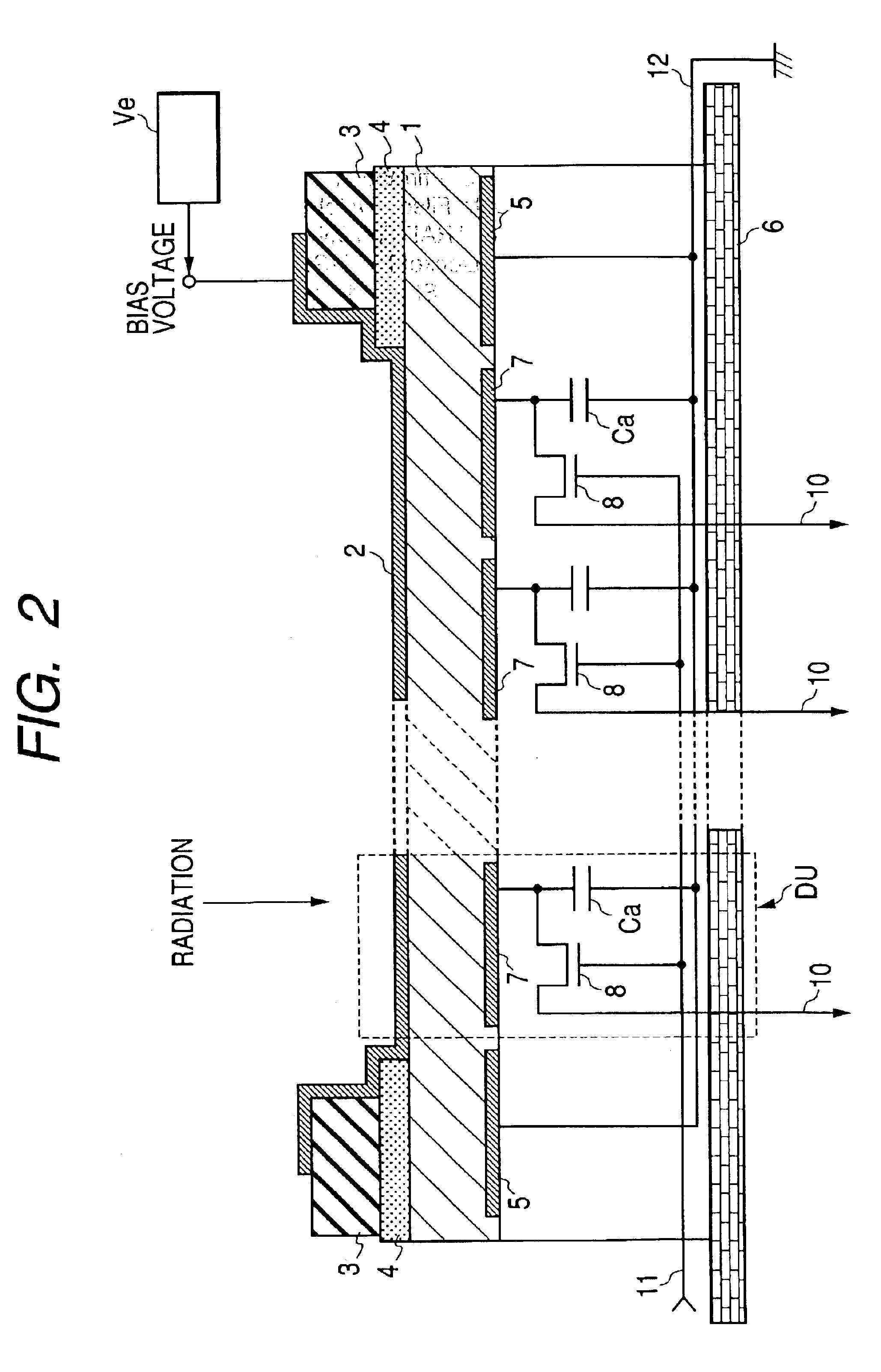Radiation detector
a detector and radiation technology, applied in the field of radiation detectors, can solve the problems of end edge portion, detector cannot operate in normal operation, and the probability of causing discharge breakdown is rapidly increased, and achieve the effect of stable detecting operation
- Summary
- Abstract
- Description
- Claims
- Application Information
AI Technical Summary
Benefits of technology
Problems solved by technology
Method used
Image
Examples
first embodiment
[0046]As shown in FIG. 1, a radiation detector of the first embodiment includes an insulating substrate 6 of a glass substrate or the like, an amorphous semiconductor thick film 1, and a voltage application electrode 2, which serve as a radiation sensor portion. The insulating substrate 6 is formed with a capacitor Ca comprising SiO2 layer or the like and a switching element 8, for example, a transistor (TFT), which is brought into a normally OFF (cut) state, for outputting charge stored at the capacitor Ca. The amorphous semiconductor thick film 1 is electrically connected to the charge storage capacitor Ca and formed above the insulating substrate 6 via a carrier collection electrode 7. In the amorphous semiconductor thick film 1, charge transfer media (carriers) are generated by incidence of radiation. The voltage application electrode 2 is provided at a surface of the amorphous semiconductor thick film 1 which is a radiation incident side.
[0047]The radiation detector of the firs...
second embodiment
[0051]Further, shown in FIG. 2, an Sb2S3 film which is a high resistance film 4 which is provided with the solvent resistance property and the carrier selective property, is formed by a thickness of about 1 μm at least between the amorphous semiconductor thick film 1 and the insulating substance 3 with the high withstand voltage property. Although the Sb2S3 film is pointed out as an example of the high resistance film 4 which is provided with the solvent resistance property and the carrier selective property, other than Sb2S3, an inorganic semiconductor film of CdS, AsSe, SeTe, CdTe or the like and an organic film material of polycarbonate or the like added with a carrier transfer material, can be used. Although film thicknesses of these differ by selectivity of carrier, solvent resistance property, or adherence to the amorphous semiconductor thick film 1, the film thicknesses can be selected in a range of 0.05 μm through 10 μm. Further, although as the carrier selective high resis...
third embodiment
[0062]Next, an explanation will be given of a method of forming the radiation sensor portion by taking an example of the case of the third embodiment shown in FIG. 3. First, the thin film transistor for the switching element 8, the capacitor Ca and the carrier collection electrode 7 are formed on the surface of the insulating substrate 6 by utilizing a thin film forming technique by a vacuum film forming process and a patterning technique by a photolithography process. Next, the amorphous semiconductor thick film 1, the carrier selective high resistance film 4, the high withstand voltage insulating substance 3 and the voltage application electrode 2 are laminated successively on the insulating substrate 6, so that the radiation sensor portion is finished.
[0063]Here, as the high withstand voltage insulating substance 3, silicone resin can be used. In such a case, there is used a material in which the viscosity of the high withstand voltage insulating silicone resin is adjusted by usi...
PUM
 Login to View More
Login to View More Abstract
Description
Claims
Application Information
 Login to View More
Login to View More - R&D
- Intellectual Property
- Life Sciences
- Materials
- Tech Scout
- Unparalleled Data Quality
- Higher Quality Content
- 60% Fewer Hallucinations
Browse by: Latest US Patents, China's latest patents, Technical Efficacy Thesaurus, Application Domain, Technology Topic, Popular Technical Reports.
© 2025 PatSnap. All rights reserved.Legal|Privacy policy|Modern Slavery Act Transparency Statement|Sitemap|About US| Contact US: help@patsnap.com



